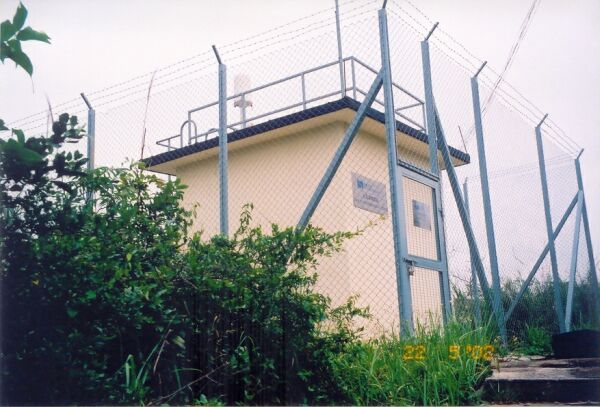25th Anniversary of the Hong Kong Observatory Short-period Seismograph Network - A Better Understanding of the Characteristics of Local Earthquakes
25th Anniversary of the Hong Kong Observatory Short-period Seismograph Network - A Better Understanding of the Characteristics of Local Earthquakes (30 November 2004)
|
The intense earthquakes that hit Japan and Taiwan in recent months have raised the awareness of Hong Kong people about the safety of touring in these places. The Hong Kong Observatory has posted on its website http://www.weather.gov.hk/gts/equake/eq_safety_e.htm some earthquake safety rules.
"People travelling to seismic active areas should know the dos and don'ts during an earthquake," the Senior Scientific Officer of the Hong Kong Observatory (HKO), Dr W T Wong, said. "When an earthquake occurs, people caught indoors should take cover under any large furniture and stay away from glass or loose hanging objects. Those in open area should keep away from buildings, steep slopes, and utility wires. After an earthquake, people should stay out of severely damaged buildings and report any damage to the authorities".
Japan and Taiwan, situated along the circum-Pacific seismic belt, experience frequent earth tremors. In comparison, Hong Kong is not located in seismic active zones and the chance for an intense earthquake occurring here is rather low. However, to meet the needs of engineering design, the Hong Kong Observatory has paid due attention to monitoring earthquakes in the vicinity of Hong Kong and, in November 1979, established a short-period seismograph network. This month (November) is the 25th anniversary of the short-period seismograph network.
The seismometers used in this seismograph network are sensitive to seismic waves with periods of around one second, and are suitable for detecting nearby earthquakes. The network initially comprised of three seismograph stations located at Yuen Ng Fan, Cheung Chau and Tsim Bei Tsui. Seismic data was transmitted in real-time to the Hong Kong Observatory Headquarters via dedicated data lines for analysis and archival by a microcomputer data processing system designed and constructed in-house. This was one of the earliest applications of microcomputer for automatic acquisition and processing of telemetric data in Hong Kong. In 1997, the Hong Kong Observatory and the Geotechnical Engineering Office worked together to establish additional seismograph stations at Cape D'Aguilar, Lead Mine Pass, Luk Keng, Siu Lam and Keung Shan, making up a total of eight seismograph stations in the network. The new seismometers used were sensitive to seismic waves with periods from 0.03 to 1 second. The precision of epicentre determination was improved to within 10 kilometres and ground motions down to one nanometre could also be detected.
Since 1999, the Hong Kong Observatory and the Centre for Earthquake Engineering Research (CEER) of the Hong Kong University (HKU) have made use of the seismic data obtained from the short-period seismograph network to study the transmission of seismic waves in the vicinity of Hong Kong, with a view to getting a better understanding of seismic risk in the region. Director of CEER of HKU Professor Adrian Chandler said the results of co-operative studies between HKU and HKO would provide information to help engineers to make detailed seismic risk assessments for the buildings in Hong Kong.
The Hong Kong Observatory has a long history of monitoring earthquakes, that goes back to 1921 when the first seismograph was installed at the Hong Kong Observatory Headquarters at Tsim Sha Tsui. At the same time, the Hong Kong Observatory also began to keep a record of locally felt tremors reported by the people of Hong Kong. The seismometer used was of the long-period type, sensitive to seismic waves with periods around 15 seconds and was suitable for detecting distant earthquakes. The seismic signals detected enabled the determination of the epicentres of intense earthquakes when analysed with data obtained by seismographs in other countries. The long-period seismometer now in use at the Hong Kong Observatory Headquarters has been in operation for nearly 50 years, since the International Geophysical Year of 1958.
The Hong Kong Observatory plans to acquire a broadband seismometer next year to replace the existing long-period seismometer. The new seismometer will enable seismic analysis and epicentre determination to be done with higher accuracies, and will also provide more comprehensive seismic information for use by the construction industry. A broadband seismometer responds well to seismic waves with periods from 0.02 to 100 seconds, overcoming the limitations of long-period and short-period seismometers.
From 1979 to 2004, the Hong Kong Observatory has recorded 51 locally felt earth tremors. Among these events, six earthquakes occurred within Hong Kong including one in 1983 at Mai Po, two in 1982 and three in 1995 over the sea east of the Lantau Island. These six earthquakes were very light with magnitudes of one to three on the Richter scale. There were seven other locally felt tremors caused by earthquakes near Heyuan in Guangdong with magnitudes of about four on the Richter scale. Most of the other events were caused by earthquakes more than 200 kilometres from Hong Kong. Among them, 20 occurred more than 500 kilometres from Hong Kong. Details of these events can be found at the Hong Kong Observatory website at http://www.weather.gov.hk/gts/equake/79felt_e.htm.
The long-period seismographs installed at the Hong Kong Observatory Headquarters in 1921 (operated from October 1921 to December 1941)
A seismogram recorded in 1929.
In 1979, the Hong Kong Observatory designed and constructed a microcomputer data processing system for automatic acquisition of data from the short-period seismograph network.
Yuen Ng Fan Seismograph Station.
The short-period seismograph network in 1997. |




